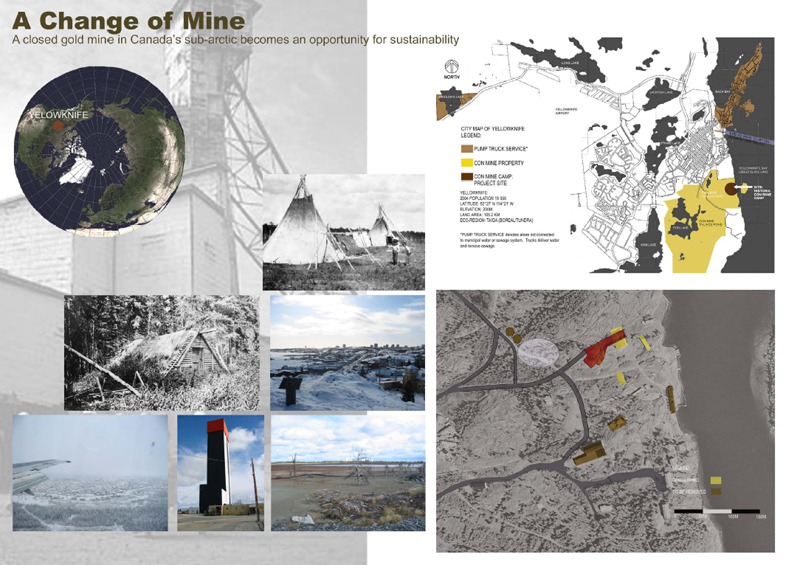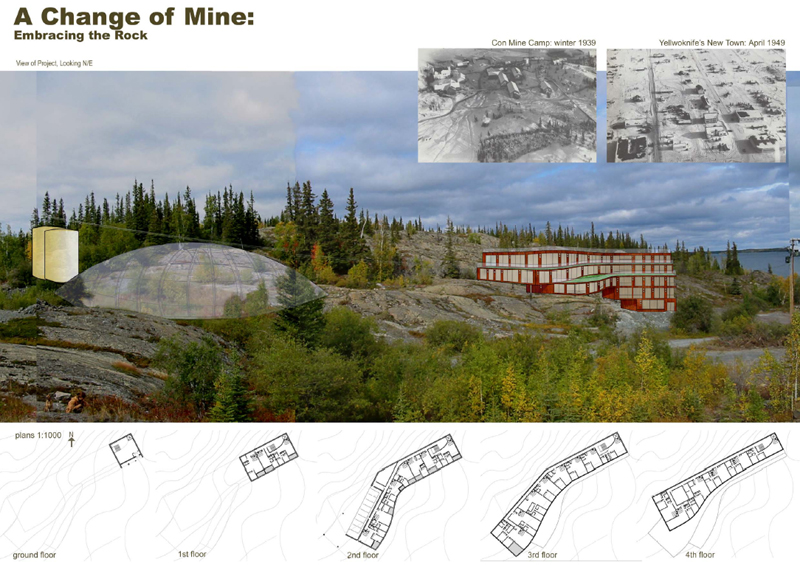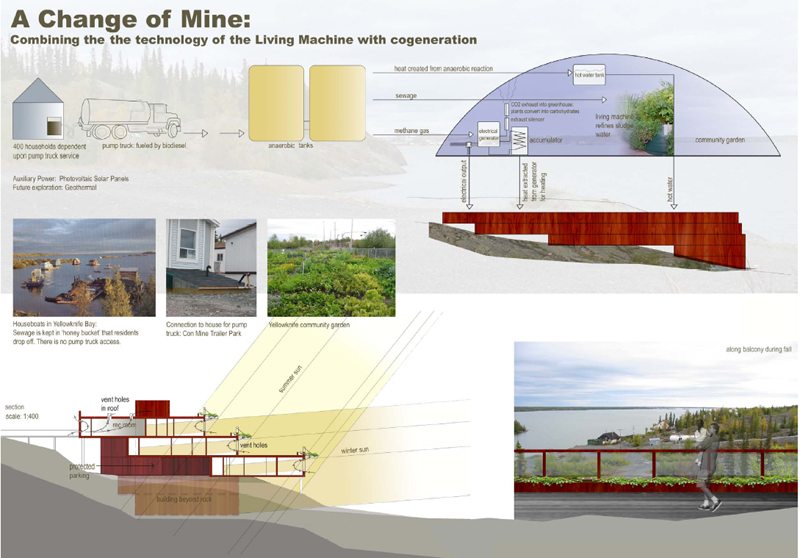


A Change of Mine: A closed mine becomes an opportunity for sustainability
Yellowknife, Northwest Territory, Canada
It is said lightheartedly that Yellowknife is a city where the gold is paved by streets. This is because far below the city’s streets are a series of tunnels for the mining of gold.
On September 5 th 1938, Con mine produced its first gold brick. It remains one of the most productive gold mining sites in Canadian history and was the main reason for the continued settlement of the Great Slave Lake region. At the end of 2003, the mine, stripped of its gold was closed. Left behind are tracts of damaged land slated for ecological regeneration and a former ‘camp’ for Con Mine workers and their families. On the site, a few ruins are left – slated by the company for removal. It is on this site that a sustainable housing project is proposed. The location is close to the downtown core (10-15 min walk) and is adjacent to Yellowknife Bay.
Design:
During the cold dark months of winter in Yellowknife, warm sunlight is a commodity appreciated by all residents. By January, the sun will rise at 10am and will set around 3pm. During these few daylight hours, the sun remains very low in the sky. It is described as ‘feeling like morning, all day’.
The proposed housing development maximizes valuable winter sun through a careful selection of site. The structure backs onto a south/southeast facing slope with ample glazing covering the south(east) elevations. It is important to provide as much natural light as possible with the light limitations in winter. Windows in this climate need to be of the highest quality and r-value. Moving parts in windows do not generally survive many freeze-thaw cycles so instead of operable windows, ventilation port holes (the same as used on ships) are placed in the wall. These ventilation holes are specifically placed for maximum air movement and multiples are used for volume. The placement on the slope also protects the structure from harsh winds driving from the northwest providing a more protected microclimate.
Winter being a major concern, the short summer months are often not considered in northern solar design. June, July and August have many hours of sunlight with the sky never reaching complete darkness. Thus, buildings have the potential of 21 hours a day of heat gain. Shading devices are an extremely important element to consider. Light-weight or ‘tacked-on’ devices will not withstand the harsh climate of the north. Another issue is the great variant between the requirements for summer and winter. It was therefore decided that trellises and planters would be placed on balconies, roof terraces and above windows for vegetation to cover during the summer months and die off during the winter. The benefits of this low-tech approach include the ability of the individual resident to control how much light gets in, and the pleasure of being surrounded by greenery.
The Precambrian rock that characterizes the harsh and beautiful landscape of Yellowknife is habitually blasted away for the construction of any new building. Many square kilometers of land were blasted to a gentle flat as Yellowknife built a new town in the 1940s. With this housing project, minimal if any blasting is required. There exists a series of structures that simply use the stable rock as a foundation and attach directly to it and this housing project continues on in this manner.
The individual units were designed with care and planning in relation to life in Yellowknife. Ample storage is provided as most Yellowknifer’s require a vast variety of clothing and recreational equipment due to climate. Storage for winter parkas, skis, etc is imperative to induce citizens to live in a denser apartment or condo environment – rather than a trailer. Generous spaces and amenities are also provided for an extremely wealthy population with the median family income of $81 544 CAN.
Construction:
There are no commercial building materials in the region. For that reason, reuse of any possible woods on the Con Mine site (the abandoned structures) will be used in the construction of the residential project. Experimentation with local lumber includes the use of rough timber for the trellis system.
Self Sufficient Energy: The problem of power
Yellowknife currently receives most of its electrical power from a hydro dam and oil generators. Much of Canada’s fossil fuel deposits are located in northern regions. However, the refinement takes place in the southern regions and thus the prices of fuel in the north are notably higher than in the rest of the country. Some photovoltaics have been installed and are showing promise in the production of electricity during the spring, summer and fall months. However lack of sunlight during winter months means that an additional power source is required to supplement the solar production. Wind is generally used in many regions but the extreme climate often wreaks havoc on the turbine (moving parts in extreme cold/wet/icy/dry) and many are left broken and unproductive. In addition to this, there are stretches of days during the winter when there is neither much sun nor wind. Thus the production of clean energy (particularly at the medium scale) seems almost impossible in Yellowknife with geothermal being a hopeful area for future, large scale development. A creative solution for providing electricity for the residents of the housing project must be found. This solution requires the co-operation of a few neighbors.
Sewage waste co-generation: nothing wasted
Including the community of Dettah (an aboriginal community of 200 connected by 6km ice road or 27 km of year round road), there are about 400 households in the Yellowknife area that are not connected to the municipal sewage/water system. A tank within the home collects the waste and it is pumped out by truck once or twice a week. People who live in houseboats bring their own waste to the facility.
Energy Proposal:
Instead of bringing this waste to the Fiddlers Lake facility, this proposition suggests relocation to an area on the Con Mine site (a much shorter haul for the trucks) where the sewage can be placed in an anaerobic reactor:
-In the reactor: 1) heat is produced as the sewage is broken down
2) Methane is produced
-The heat from the sewage break down can be used to heat water for the residents and the methane can be burned for the production of electricity. The sewage itself can then be treated in the living machine located in the green house.
-the heat produced when the electricity is generated can be used to heat the housing project and greenhouse.
-the Carbon dioxide can be released into the greenhouse for plants to utilize (increasing plant productivity)
*Pump trucks can be adapted to use bio-diesel (perhaps used cooking oil from the local restaurants)
Electricity production can be supplemented with photovoltaics located in the greenhouse and some areas of the housing development itself.
Conclusion
Living in Canada’s north has required intense dependence on one’s community throughout history. The extremely harsh climate and isolation leaves one breathless of wonder. In the same vein, this housing development depends upon the participation (sewage) of local community members.
Resting on a site of healing landscape, the project generates a new direction for design and method of living.